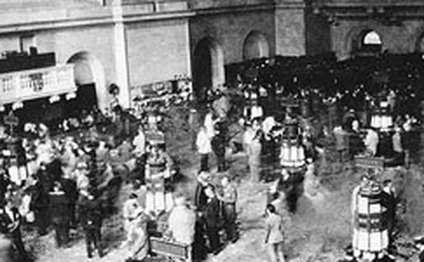Get MONEY

The 1920's was a decde of a flourishing economy. Employment was up ansd people had spare money to spend of luxuries such as the latest in technologies or the new and budding forms of entertainment.
The real GNP per capita, a way to measure a growing economy, reached 2.7 percdent between 1920 and 1929.By twnetieth and twenty-first century standards it was a relatively rapid growth. In 1920-1921 a slight depression took placeand lasted about a year but a fast recovery re-established full employment by 1923. Despite the slight depression and minor interruptions throughout the twenties, the American economy exhibited impressive economic growth.New ways of production and new products helped to spurr this growth. It was the combination of widespread use of electricity and new production methods that created the economic growth.
New products and services were created with the advancing technology which then created a new market and added greatly to the economy. Examples of new products were radios, electric iceboxes, lectric irons, fans, lighting, and vacuum cleaners. Newly formed companies that produced these devices became highly successful and profitable and lead to the stock market boom of the 1920's.
Agriculture delined in Europe and America's agricultural production grew to fit the expanding demand. This lead to a rise in farm product prices and income. Out put was increased by farmers by purchasing more equipment such as tractors, plow, mowers, and threshers. As the demand for more farmland increased, so did the prices and the debt of farmers in America.
In the 1920's, America became known as a dominant industrial force in the world. This was due to the many developments made by America such as mass production and continuous processing.
In 1929, the stock market crashed. This would lead to the Great Depression which America would endure in the coming decade and would not recover from until World War II. Many people had started to invest in the stock market making millionaires out of those who truly knew how to play the game. But on Black Thursday, October 24th, 1929, stocks began to fall rapidly. The next day wealthy bankers met to eleviate the stock market and bring the prices back up. The major banks that met were Morgan Bank, Chase National Bank, and National City Bank. Although they tried, their attempts were unsuccessful and the Roaring Twenties fell to the Greta Depression of the 1930's.
The real GNP per capita, a way to measure a growing economy, reached 2.7 percdent between 1920 and 1929.By twnetieth and twenty-first century standards it was a relatively rapid growth. In 1920-1921 a slight depression took placeand lasted about a year but a fast recovery re-established full employment by 1923. Despite the slight depression and minor interruptions throughout the twenties, the American economy exhibited impressive economic growth.New ways of production and new products helped to spurr this growth. It was the combination of widespread use of electricity and new production methods that created the economic growth.
New products and services were created with the advancing technology which then created a new market and added greatly to the economy. Examples of new products were radios, electric iceboxes, lectric irons, fans, lighting, and vacuum cleaners. Newly formed companies that produced these devices became highly successful and profitable and lead to the stock market boom of the 1920's.
Agriculture delined in Europe and America's agricultural production grew to fit the expanding demand. This lead to a rise in farm product prices and income. Out put was increased by farmers by purchasing more equipment such as tractors, plow, mowers, and threshers. As the demand for more farmland increased, so did the prices and the debt of farmers in America.
In the 1920's, America became known as a dominant industrial force in the world. This was due to the many developments made by America such as mass production and continuous processing.
In 1929, the stock market crashed. This would lead to the Great Depression which America would endure in the coming decade and would not recover from until World War II. Many people had started to invest in the stock market making millionaires out of those who truly knew how to play the game. But on Black Thursday, October 24th, 1929, stocks began to fall rapidly. The next day wealthy bankers met to eleviate the stock market and bring the prices back up. The major banks that met were Morgan Bank, Chase National Bank, and National City Bank. Although they tried, their attempts were unsuccessful and the Roaring Twenties fell to the Greta Depression of the 1930's.
